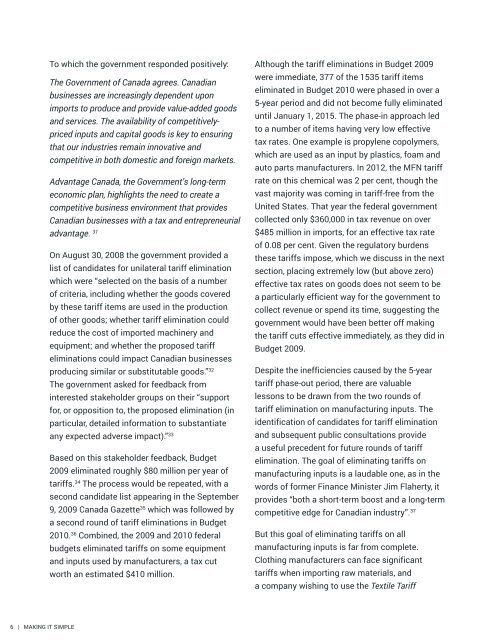Making it Simple
119_making_it_simple
119_making_it_simple
Create successful ePaper yourself
Turn your PDF publications into a flip-book with our unique Google optimized e-Paper software.
To which the government responded pos<strong>it</strong>ively:<br />
The Government of Canada agrees. Canadian<br />
businesses are increasingly dependent upon<br />
imports to produce and provide value-added goods<br />
and services. The availabil<strong>it</strong>y of compet<strong>it</strong>ivelypriced<br />
inputs and cap<strong>it</strong>al goods is key to ensuring<br />
that our industries remain innovative and<br />
compet<strong>it</strong>ive in both domestic and foreign markets.<br />
Advantage Canada, the Government’s long-term<br />
economic plan, highlights the need to create a<br />
compet<strong>it</strong>ive business environment that provides<br />
Canadian businesses w<strong>it</strong>h a tax and entrepreneurial<br />
advantage. 31<br />
On August 30, 2008 the government provided a<br />
list of candidates for unilateral tariff elimination<br />
which were “selected on the basis of a number<br />
of cr<strong>it</strong>eria, including whether the goods covered<br />
by these tariff <strong>it</strong>ems are used in the production<br />
of other goods; whether tariff elimination could<br />
reduce the cost of imported machinery and<br />
equipment; and whether the proposed tariff<br />
eliminations could impact Canadian businesses<br />
producing similar or subst<strong>it</strong>utable goods.” 32<br />
The government asked for feedback from<br />
interested stakeholder groups on their “support<br />
for, or oppos<strong>it</strong>ion to, the proposed elimination (in<br />
particular, detailed information to substantiate<br />
any expected adverse impact).” 33<br />
Based on this stakeholder feedback, Budget<br />
2009 eliminated roughly $80 million per year of<br />
tariffs. 34 The process would be repeated, w<strong>it</strong>h a<br />
second candidate list appearing in the September<br />
9, 2009 Canada Gazette 35 which was followed by<br />
a second round of tariff eliminations in Budget<br />
2010. 36 Combined, the 2009 and 2010 federal<br />
budgets eliminated tariffs on some equipment<br />
and inputs used by manufacturers, a tax cut<br />
worth an estimated $410 million.<br />
Although the tariff eliminations in Budget 2009<br />
were immediate, 377 of the 1535 tariff <strong>it</strong>ems<br />
eliminated in Budget 2010 were phased in over a<br />
5-year period and did not become fully eliminated<br />
until January 1, 2015. The phase-in approach led<br />
to a number of <strong>it</strong>ems having very low effective<br />
tax rates. One example is propylene copolymers,<br />
which are used as an input by plastics, foam and<br />
auto parts manufacturers. In 2012, the MFN tariff<br />
rate on this chemical was 2 per cent, though the<br />
vast major<strong>it</strong>y was coming in tariff-free from the<br />
Un<strong>it</strong>ed States. That year the federal government<br />
collected only $360,000 in tax revenue on over<br />
$485 million in imports, for an effective tax rate<br />
of 0.08 per cent. Given the regulatory burdens<br />
these tariffs impose, which we discuss in the next<br />
section, placing extremely low (but above zero)<br />
effective tax rates on goods does not seem to be<br />
a particularly efficient way for the government to<br />
collect revenue or spend <strong>it</strong>s time, suggesting the<br />
government would have been better off making<br />
the tariff cuts effective immediately, as they did in<br />
Budget 2009.<br />
Desp<strong>it</strong>e the inefficiencies caused by the 5-year<br />
tariff phase-out period, there are valuable<br />
lessons to be drawn from the two rounds of<br />
tariff elimination on manufacturing inputs. The<br />
identification of candidates for tariff elimination<br />
and subsequent public consultations provide<br />
a useful precedent for future rounds of tariff<br />
elimination. The goal of eliminating tariffs on<br />
manufacturing inputs is a laudable one, as in the<br />
words of former Finance Minister Jim Flaherty, <strong>it</strong><br />
provides “both a short-term boost and a long-term<br />
compet<strong>it</strong>ive edge for Canadian industry”. 37<br />
But this goal of eliminating tariffs on all<br />
manufacturing inputs is far from complete.<br />
Clothing manufacturers can face significant<br />
tariffs when importing raw materials, and<br />
a company wishing to use the Textile Tariff<br />
6 | making <strong>it</strong> simple


